By definition, xenoliths are foreign blocks entrained by a magma body, blocks that are not derived from the magma itself (as are the autoliths). Xenoliths are therefore generally blocks of rock broken off of the walls or roof of the pluton. In the Skaergaard pluton itself, I saw four different kinds of xenoliths: basalt lava flow xenoliths in the MBS, sedimentary xenoliths in the MBS, wherlite (olivine-CPX) xenoliths in the MBS, basalt lava flow xenoliths in the Layered Series, and archean gneiss xenoliths in a basalt dike. All of the wall xenoliths are in the Marginal Border Series, MBST. The roof xenoliths we saw are in the Layered Series, specifically the MZ.
Basalt xenoliths in the Marginal Border Series
These were mostly seen adjacent to the Skaergaard pluton contact on the southwestern point of Ivnarmiut Island. These xenoliths include angular blocks of massive basalt, and basalt that appears to have white amygdules. I took no samples of these so I don’t know what the white things are made of.

A relatively large basalt xenolith, and several smaller ones, several of which are vesicular (bottom center). Skaergaard contact is a few meters to the upper left, under the water.
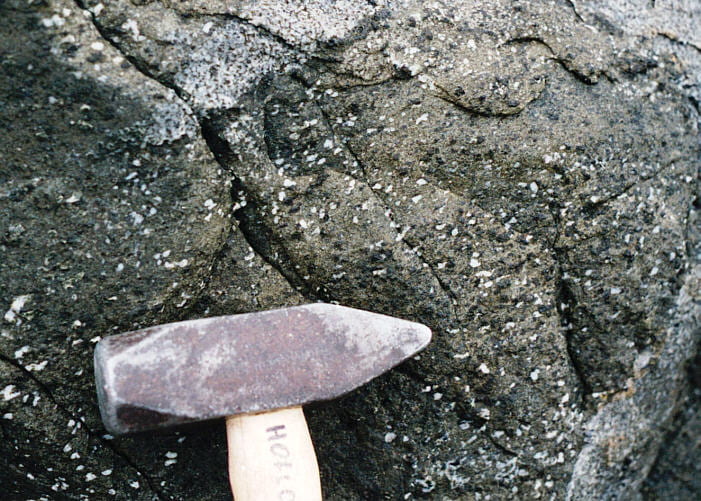
Close-up of a vesicular basalt xenolith in the MBST Skaergaard gabbro.
Xenoliths of Cretaceous sedimentary rocks
The sedimentary sequence was probably once extensive in the Skaergaard region. Now it is mostly eroded away or hidden beneath the Tertiary lavas (see geologic map). Blocks of these sediments were incorporated into the Marginal Border Series, MBST. Unlike the rather refractory basalt xenoliths, the sediments underwent profound contact metamorphism, partial melting, and reaction with the enclosing magma.
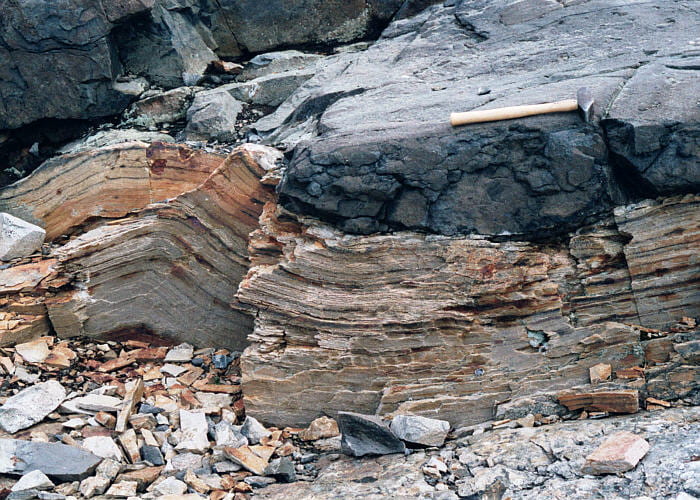
Not a xenolith, but the best example we saw of the layered Cretaceous sediments, here at the Skaergaard gabbro contact on Mellemø Island. Dark rock above is the Skaergaard chilled margin gabbro, below which are ~0.8 m of contact metamorphosed Cretaceous sediments, and below that, on the exposed subhorizontal surface, is Archean gneiss, on which the Cretaceous sediments unconformably rest.

A sedimentary xenolith several meters from the Skaergaard pluton contact, on Ivnarmiut Island. This small xenolith has a granofels interior and a partially melted and chemically modified margin. There is a black (magnetite?) reaction rim between the highly modified outer part of the xenolith, and the granofels interior.
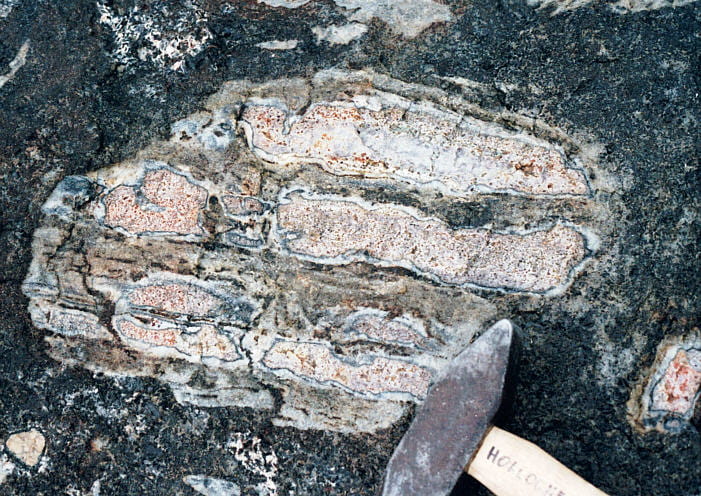
A somewhat larger xenolith than that in the image immediately above, about a meter away, with layering that has been differentially melted and reacted.

Close-up of the xenolith in the photo above. Though difficult to tell in the dark and rain, it looks like this sample contains cordierite, spinel, feldspar, and rutile.

Composite block of gabbro containing numerous sedimentary xenoliths.
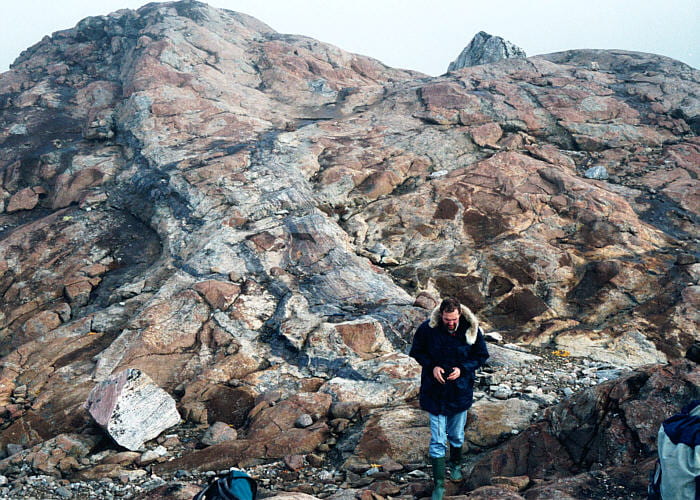
Xenolith breccia at ~160 m elevation near the western Skaergaard contact on southeastern Kraemer Island. Most of the smaller xenoliths here are ultramafic, probably similar to the wherlite on the Uttental Plateau, shown below in the next section. The large, light-colored, layered, elongate block in the center is metamorphosed Cretaceous sediment, containing spinel, magnetite, ilmenite, and cordierite. This is the same area as that shown in Irvine et al. (1998), their Figure 8.
Wherlite xenoliths
These ultramafic xenoliths occur in in MBST along the west and especially northwest side of the pluton. These rocks are much more primitive (i.e., Mg-rich) than any of the exposed Skaergaard pluton, and are considered to be blocks of a preexisting ultramafic body, which the Skaergaard intruded.

This is a swarm of the ultramafic xenoliths (dark-brown) mentioned for the image immediately above, near the contact at ~160 m elevation on southeastern Kraemer Island. The large, layered sedimentary xenolith exposed here is on the far left.

Photo of a nicely weathered outcrop at the same location as the previous two images, immediately above, showing numerous ultramafic xenoliths and a few partially melted sedimentary xenoliths.

The Marginal Boarder Series near the northwestern pluton contact, a few meters above Uttental Sund, and below the Uttental Plateau. This shows ultramafic xenoliths (cumulate wherlite with interstitial plagioclase) included within MBS gabbro. The olivine in the xenoliths is Fo80-85, which is too Mg-rich for Skaergaard if the hidden zone is small, as recent gravity models indicate. It seems likely that wherlite is from ultramafic cumulates in a somewhat older Tertiary pluton that was intruded by the Skaergaard. Such bodies apparently are found in the area.

Closer view of a fresher surface, showing densely packed wherlite xenoliths, larger grains visible are partially serpentinized olivine.

Close-up of one of the wherlite xenoliths, the larger crystals being partially serpentinized olivine, with smaller pyroxene crystals and interstitial plagioclase. Thin section photos here.
Basalt xenoliths in the Layered Series
Basalt xenoliths are especially abundant in one part of the MZ, on southeast part of Kraemer Island. These are distinctive from the basalt xenoliths in MBZT, in that their degree of contact metamorphism and recrystallization is much more severe. In thin section, textures are metamorphic.

Top of a large basalt xenolith block, showing the sharp contact, some magnetite in a reaction rind, and small magnetite-rich gabbro dikelets that were emplaced in fractures during or soon after block emplacement. Thin section here.
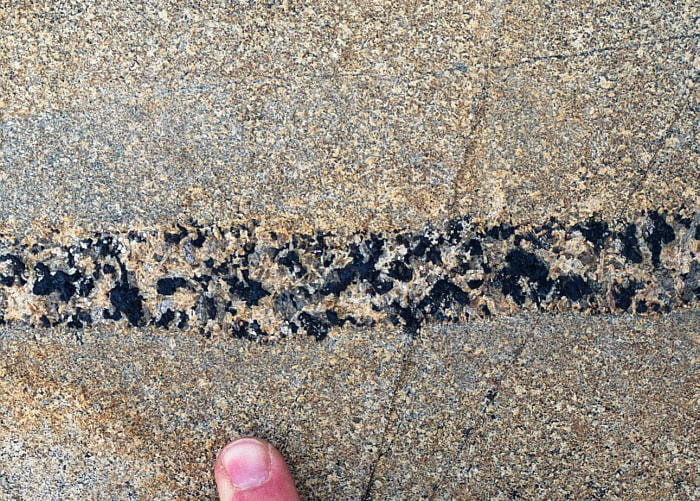
Close-up view of one of the larger magnetite-rich dikelets cutting the block in the image above. These dikes essentially have MZ mineralogy, though they are somewhat richer in magnetite than most of the MZ.

A smaller, rusty, olivine-bearing xenolith is just above the photo center, and another one is visible to the lower center and right. Thin section photos here.

Close-up of the xenolith in the photo above, showing the rounded outer margin of a rusty, olivine-bearing basalt xenolith, with a prominent oxide-rich reaction rind. This block has pits weathering out in a pattern that resembles amygdules, though they may be something else (see below).

A block bearing layered rocks of the UBS, presumably UBST, and attached basalt, therefore representing a foundered piece of the Skaergaard roof contact. The basalts are the irregularly mottled rock on the left, under and to the left of the woman in red, and the layered UBST rock is under all the people wearing blue and green. The contact is just to the left of the white pants. The UBST layering in the block dips steeply down to the left, whereas the layering in the host MZ rock dips shallowly down the slope in the background.

The edge of a large, rusty basalt block above, with MZ gabbro below, bearing small chips of rusty, fine-grained basalt.

Close-up of the pits in a rusty basalt block. These pits are not shaped like round amygdules, but rather look like irregular, perhaps radiating, crystals or oikocrysts, possibly olivine.
Archean gneiss xenoliths in a dike

A basaltic dike cutting LZb on Kraemer Island, containing numerous xenoliths of felsic gneiss. View is approximately east, toward Uttental Sund, barely visible at the upper left.
